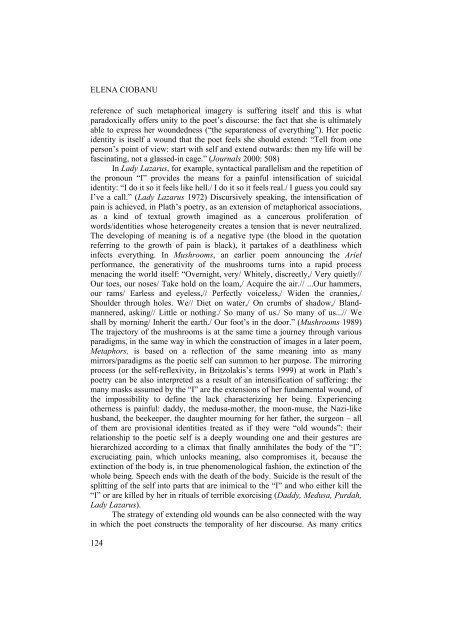culture, subculture and counterculture - Facultatea de Litere
culture, subculture and counterculture - Facultatea de Litere
culture, subculture and counterculture - Facultatea de Litere
You also want an ePaper? Increase the reach of your titles
YUMPU automatically turns print PDFs into web optimized ePapers that Google loves.
ELENA CIOBANU<br />
reference of such metaphorical imagery is suffering itself <strong>and</strong> this is what<br />
paradoxically offers unity to the poet’s discourse: the fact that she is ultimately<br />
able to express her woun<strong>de</strong>dness (“the separateness of everything”). Her poetic<br />
i<strong>de</strong>ntity is itself a wound that the poet feels she should extend: “Tell from one<br />
person’s point of view: start with self <strong>and</strong> extend outwards: then my life will be<br />
fascinating, not a glassed-in cage.” (Journals 2000: 508)<br />
In Lady Lazarus, for example, syntactical parallelism <strong>and</strong> the repetition of<br />
the pronoun “I” provi<strong>de</strong>s the means for a painful intensification of suicidal<br />
i<strong>de</strong>ntity: “I do it so it feels like hell./ I do it so it feels real./ I guess you could say<br />
I’ve a call.” (Lady Lazarus 1972) Discursively speaking, the intensification of<br />
pain is achieved, in Plath’s poetry, as an extension of metaphorical associations,<br />
as a kind of textual growth imagined as a cancerous proliferation of<br />
words/i<strong>de</strong>ntities whose heterogeneity creates a tension that is never neutralized.<br />
The <strong>de</strong>veloping of meaning is of a negative type (the blood in the quotation<br />
referring to the growth of pain is black), it partakes of a <strong>de</strong>athliness which<br />
infects everything. In Mushrooms, an earlier poem announcing the Ariel<br />
performance, the generativity of the mushrooms turns into a rapid process<br />
menacing the world itself: “Overnight, very/ Whitely, discreetly,/ Very quietly//<br />
Our toes, our noses/ Take hold on the loam,/ Acquire the air.// ...Our hammers,<br />
our rams/ Earless <strong>and</strong> eyeless,// Perfectly voiceless,/ Wi<strong>de</strong>n the crannies,/<br />
Shoul<strong>de</strong>r through holes. We// Diet on water,/ On crumbs of shadow,/ Bl<strong>and</strong>mannered,<br />
asking// Little or nothing./ So many of us./ So many of us...// We<br />
shall by morning/ Inherit the earth./ Our foot’s in the door.” (Mushrooms 1989)<br />
The trajectory of the mushrooms is at the same time a journey through various<br />
paradigms, in the same way in which the construction of images in a later poem,<br />
Metaphors, is based on a reflection of the same meaning into as many<br />
mirrors/paradigms as the poetic self can summon to her purpose. The mirroring<br />
process (or the self-reflexivity, in Britzolakis’s terms 1999) at work in Plath’s<br />
poetry can be also interpreted as a result of an intensification of suffering: the<br />
many masks assumed by the “I” are the extensions of her fundamental wound, of<br />
the impossibility to <strong>de</strong>fine the lack characterizing her being. Experiencing<br />
otherness is painful: daddy, the medusa-mother, the moon-muse, the Nazi-like<br />
husb<strong>and</strong>, the beekeeper, the daughter mourning for her father, the surgeon – all<br />
of them are provisional i<strong>de</strong>ntities treated as if they were “old wounds”: their<br />
relationship to the poetic self is a <strong>de</strong>eply wounding one <strong>and</strong> their gestures are<br />
hierarchized according to a climax that finally annihilates the body of the “I”:<br />
excruciating pain, which unlocks meaning, also compromises it, because the<br />
extinction of the body is, in true phenomenological fashion, the extinction of the<br />
whole being. Speech ends with the <strong>de</strong>ath of the body. Suici<strong>de</strong> is the result of the<br />
splitting of the self into parts that are inimical to the “I” <strong>and</strong> who either kill the<br />
“I” or are killed by her in rituals of terrible exorcising (Daddy, Medusa, Purdah,<br />
Lady Lazarus).<br />
The strategy of extending old wounds can be also connected with the way<br />
in which the poet constructs the temporality of her discourse. As many critics<br />
124












